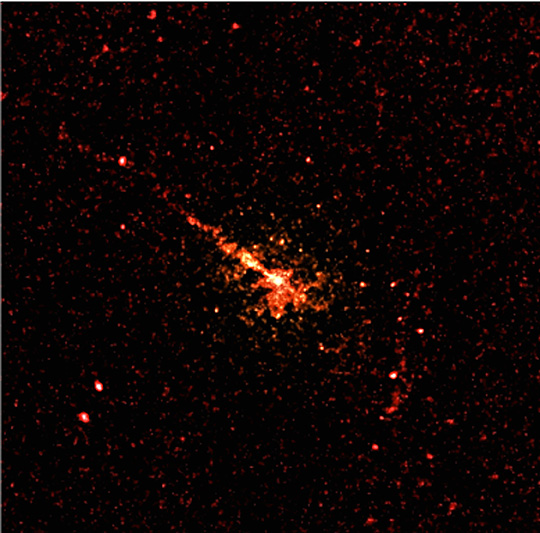October 25, 1999
CXC PR: 99-08
NASA's Chandra X-ray Observatory has made an extraordinary image of Centaurus A, a nearby galaxy noted for its explosive activity. The image shows X-ray jets erupting from the center of the galaxy over a distance of 25,000 light years. Also detected are a group of X-ray sources clustered around the nucleus, which is believed to harbor a supermassive black hole. The X-ray jets and the cluster of sources may be a byproduct of a titanic collision between galaxies several hundred million years ago.
"This image is great," said Dr. Ethan Schreier of the Space Telescope Science Institute, "For twenty years we have been trying to understand what produced the X rays seen in the Centaurus A jet. Now we at last know that the X-ray emission is produced by extremely high-energy electrons spiraling around a magnetic field." Schreier explained that the length and shape of the X-ray jet pinned down the source of the radiation. The entire length of the X-ray jet is comparable to the diameter of the Milky Way Galaxy.
Other features of the image excite scientists. "Besides the jets, one of the first things I noticed about the image was the new population of sources in the center of the galaxy," said Dr. Christine Jones from the Harvard-Smithsonian Center for Astrophysics . "They are grouped in a sphere around the nucleus, which must be telling us something very fundamental about how the galaxy, and the supermassive black hole in the center, were formed."
Astronomers have accumulated evidence with optical and infrared telescopes that Centaurus A collided with a small spiral galaxy several hundred million years ago. This collision is believed to have triggered a burst of star formation and supplied gas to fuel the activity of the central black hole.
more -
According to Dr. Giuseppina Fabbiano, of Harvard-Smithsonian, "The Chandra image is like having a whole new laboratory to work in. Now we can see the main jet, the counter jet, and the extension of the jets beyond the galaxy. It is gorgeous in the detail it reveals," she said.
Dr. Allyn Tennnant of NASA's Marshall Space Flight Center agreed. "It's incredible, being able to see all that structure in the jet," he said. "We have one fine X-ray telescope."
Indeed at a distance of eleven million light years from Earth, Centaurus A has long been a favorite target of astronomers because it is the nearest example of a class of galaxies called active galaxies. Active galaxies are noted for their explosive activity, which is presumed to be due to a supermassive black hole in their center. The energy output due to the huge central black hole can in many cases affect the appearance of the entire galaxy.
The Chandra X-ray image of Cen A, made with the High Resolution Camera, shows a bright source in the nucleus of the galaxy at the location of the suspected supermassive black hole. The bright jet extending out from the nucleus to the upper left is due to explosive activity around the black hole which ejects matter at high speeds from the vicinity of the black hole. A "counter jet" extending to the lower right can also be seen. This jet is probably pointing away from us, which accounts for its faint appearance.
One of the most intriguing features of supermassive black holes is that they do not suck up all the matter that falls within their sphere of influence. Some of the matter falls inexorably toward the black hole, and some explodes away from the black hole in high-energy jets that move at near the speed of light. The presence of bright X-ray jets in the Chandra image means that electric fields are continually accelerating electrons to extremely high energies over enormous distances. Exactly how this happens is a major puzzle that Chandra may help to solve.
To follow Chandra's progress, visit the Chandra site at:
Dr. Stephen Murray of the Harvard-Smithsonian Center for Astrophysics is the principal investigator for the High Resolution Camera. NASA's Marshall Space Flight Center in Huntsville, AL, manages the Chandra program. TRW, Inc., Redondo Beach, CA, is the prime contractor for the spacecraft. The Smithsonian's Chandra X-ray Center controls science and flight operations from Cambridge, MA.
High resolution digital versions of the X-ray image (JPG, 300 dpi TIFF) and other information associated with this release are available on the Internet at:
NASA TV on the web
MEDIA CONTACTS
Steve Roy
Marshall Space Flight Center, Huntsville, AL
Phone: 256-544-6535
http://chandra.nasa.gov
Dr. Wallace Tucker
Chandra X-ray Observatory Center
Harvard-Smithsonian Center for Astrophysics, Cambridge, MA
Phone: 617-496-7998
http://chandra.harvard.edu



